Elysburg, Pennslyvania – Friday, June 13th, 2008
Am I really, finally at Knoebels? I never had the pleasure to go to Disney as a young child, tragically denied that once-in-a-lifetime experience all children must have– of getting out of the family car in the middle of a vast Florida parking lot, wide-eyed with wonder that the seemingly fictional utopian dreamland that you’ve heard about nearly since birth but never thought you would actually see is really, really, REALLY right there… somewhere, beyond that small sea of cars. I think I got as close an approximation to that experience as I can ever hope to get in my adult life as we pulled into the parking lot for Knoebels.
Knoebels is a park I’ve always felt like I should have been to, but somehow never have. It was on my radar ever since the 1990’s when all those Discovery Channel specials heaped loads of praise on the Phoenix for being the idealized “small park classic coaster”, and then there was the opening of Twister in 1999 to make it a 1-2 punch. My first real attempts to visit were in 2002 as part of a three-park visit in Pennsylvania that, due to some unforeseen complications just a few days before departure, ended up only including Hersheypark. The year after I finally managed to get Dorney Park in but Knoebels was left in the dark as well. 2004 marked my third return to Pennsylvania in three years with a second visit to Hersheypark as well as a stop to Kennywood, but again somehow Knoebels just couldn’t quite fit our schedule. It always seemed to be that one park in the region that was second or third on my list of to-do parks when the time for only one or two parks were available. In 2006 with the announcement of Flying Turns it was in the back of my mind to maybe make a weekend visit later that year if they could get it open it time. After their 2006 flood delayed things I put Knoebels at the top of my travel plans for 2007, but less than two weeks in advance of leaving that August it became clear that it still wouldn’t be open, so we made a quick swap in plans to include Busch Gardens and Dollywood (both with spectacular new for ‘07 steel going in that year) instead. Now here it was 2008 and I was finally, finally, finally going to make it no matter what, and it was all so perfect as well. Pennsylvania was ripe with new attractions everywhere (Kennywood’s Ghostwood, DelGrosso’s Revolution, Dorney’s Voodoo, and especially Hershey’s Fahrenheit and Waldameer’s Ravine Flyer II) so it just made perfect sense that this was the year, with the now opened Flying Turns, that I would finally make the holy pilgrimage to the Mecca of quirky small parks everywhere.
but again somehow Knoebels just couldn’t quite fit our schedule. It always seemed to be that one park in the region that was second or third on my list of to-do parks when the time for only one or two parks were available. In 2006 with the announcement of Flying Turns it was in the back of my mind to maybe make a weekend visit later that year if they could get it open it time. After their 2006 flood delayed things I put Knoebels at the top of my travel plans for 2007, but less than two weeks in advance of leaving that August it became clear that it still wouldn’t be open, so we made a quick swap in plans to include Busch Gardens and Dollywood (both with spectacular new for ‘07 steel going in that year) instead. Now here it was 2008 and I was finally, finally, finally going to make it no matter what, and it was all so perfect as well. Pennsylvania was ripe with new attractions everywhere (Kennywood’s Ghostwood, DelGrosso’s Revolution, Dorney’s Voodoo, and especially Hershey’s Fahrenheit and Waldameer’s Ravine Flyer II) so it just made perfect sense that this was the year, with the now opened Flying Turns, that I would finally make the holy pilgrimage to the Mecca of quirky small parks everywhere.
Wait, did I say the now opened Flying Turns? Even a year after the ride was supposed to have opened after it couldn’t quite open in time for the autumn before, it’s still nowhere near close to opening soon. I at least don’t have to kick myself for having just missed it since all signs are pointing to it still not being ready to go for the start 2009 as well… this has led to an odd situation where a small park like Knoebel’s now has three 2009 rides listed on their RCDB page, with their purchase of the currently in-storage Golden Nugget Mine Ride from Morey’s Pier and the sudden replacement of the aging High Speed Thrill Coaster with a new kiddy ride from Miler; it makes Knoebels look like a Six Flags park circa 2000.
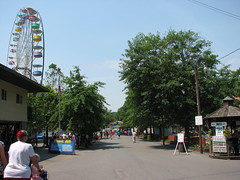 Walking into the park at first almost seemed unreal to me. It’s somehow both the smallest, most unassuming place you’d ever care to visit, and yet larger than life at the same time. It is a full-fledged resort park, after all, so I suppose you could say Knoebels is technically closer in leagues with Cedar Point or Disneyland than would a “large” stand-alone park like Dorney. It’s never really clear when you’re actually inside the park. You pass by some miscellaneous welcome signs, some makeshift mercantile stores, various camping or administrative buildings that aren’t actually part of the park, and then rides just start to fill in the landscape one-by-one until you realize you’re standing in the hub of the park and you haven’t gotten your tickets yet. Too bad, too, because my normal impulse when I first enter a park
Walking into the park at first almost seemed unreal to me. It’s somehow both the smallest, most unassuming place you’d ever care to visit, and yet larger than life at the same time. It is a full-fledged resort park, after all, so I suppose you could say Knoebels is technically closer in leagues with Cedar Point or Disneyland than would a “large” stand-alone park like Dorney. It’s never really clear when you’re actually inside the park. You pass by some miscellaneous welcome signs, some makeshift mercantile stores, various camping or administrative buildings that aren’t actually part of the park, and then rides just start to fill in the landscape one-by-one until you realize you’re standing in the hub of the park and you haven’t gotten your tickets yet. Too bad, too, because my normal impulse when I first enter a park is to jump right into whatever empty ride queue I happen to be standing right next to. Well there’s a ticket booth right in front of us with no line, that’s good… except they only sell individual ride tickets, and I’m definitely getting the unlimited all-day pass. That’s down around the corner, I’m told. So after a short scout out in that general direction I happen upon a gigantic mass of people lined up in front of a couple small log cabin pavilions. The wait to get an all-day pass ended up totaling me about an hour and ten minutes… well the good news is that the heat wave that plagued the entirety of our trip so far has finally passed for the first day of comfortable mid-70’s temps. Also, Knoebels is a damn fine place to people watch. I was worried that Knoebels, being a more off-the-beaten-path sort of establishment, might be filled with white trash, but the crowds here were very eclectic and friendly, all here to have a good time with their families, like the way people used to be in those old 1960’s and 70’s made-for-TV movies. My dad by this point was well-worn out from our previous eight days of coaster riding so he decided not to wait with me for an all-day pass, instead opting to enjoy the cooler weather on a nearby shaded bench while toying with more of the features on his camera (this is also why there’s a much larger quantity of pictures of me on my Knoebels Flickr page).
is to jump right into whatever empty ride queue I happen to be standing right next to. Well there’s a ticket booth right in front of us with no line, that’s good… except they only sell individual ride tickets, and I’m definitely getting the unlimited all-day pass. That’s down around the corner, I’m told. So after a short scout out in that general direction I happen upon a gigantic mass of people lined up in front of a couple small log cabin pavilions. The wait to get an all-day pass ended up totaling me about an hour and ten minutes… well the good news is that the heat wave that plagued the entirety of our trip so far has finally passed for the first day of comfortable mid-70’s temps. Also, Knoebels is a damn fine place to people watch. I was worried that Knoebels, being a more off-the-beaten-path sort of establishment, might be filled with white trash, but the crowds here were very eclectic and friendly, all here to have a good time with their families, like the way people used to be in those old 1960’s and 70’s made-for-TV movies. My dad by this point was well-worn out from our previous eight days of coaster riding so he decided not to wait with me for an all-day pass, instead opting to enjoy the cooler weather on a nearby shaded bench while toying with more of the features on his camera (this is also why there’s a much larger quantity of pictures of me on my Knoebels Flickr page).
More than an hour inside the park and I had yet to ride anything. I was just getting my wristband, realizing my extended wait was due to the fact that they had assigned the trainee to the most visible window location where the most people would tend to queue, including myself. Alright, finally ready to roll! I decided to get right down to business and quickly joined the queue for the Phoenix, which was out the entranceway. I see, they’re only running one-train operation. This may take a while. I’m doing the math in my head as I realize after waiting an hour for an all-day pass for $34, individual tickets for this ride only cost $2.00, and with a wait like this how many times can I expect to get on it throughout the day? I also had never realized that the entire midway in front of the Phoenix is just a sprawling field of gravel, the kind that likes to get lodged in the heel of your show.
What the hell!?! This isn’t the Knoebels I’ve dreamed about! That Knoebels is quirky and charming with rides shaded beneath huge trees, not placed on top of a parking lot, and plenty of quick lines and friendly, competent ride ops, and you never have to worry about if you’re being over-charged. After all I heard about it I expected the Phoenix to appear larger than life, but instead I was looking at it and realized it was just there, a small and insignificant ride that happened to pick up a large following who rode it on a better day than I, and now I’m really wishing that my dreams of Knoebels were turning into this reality. The line’s moving forward a bit, but to be honest there was a moment when I almost felt like bailing so I could say, “No, wait, there’s still some purity left to my vision of Knoebels, I want to save my first time for later when the moment’s actually right.”
Neurotic I am, I know. Taken out of context I doubt anyone would guess that above quote was in reference to an amusement park and not something more intimate and life-changing. Actually that attitude all took place in the span of about five minutes. They then added the second train, which drastically changed the pace of the queue and got me into the front row of what once seemed to be a another hour’s long wait in ten minutes. I got my first ride on the Phoenix. Three minutes later I met up with my dad who was  chilling at a nearby bench to await my assessment.
chilling at a nearby bench to await my assessment.
“How was it?”
“It’s in my top five for sure.”
I didn’t intend for that to happen! But I kept going over it in my head and realized it did. It was most certainly better than the Thunderbolt which is my current #5 wood, and I was trying to figure out if the quality of the ride, forces and progression would even outdo my #3 pick of Shivering Timbers.
Shit, maybe… What did I experience on that ride?
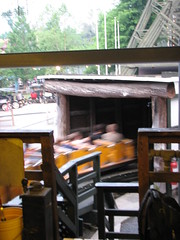 The Phoenix gets started with a mini pre-lift loop that takes place in a tunnel, mostly to allow the beginning of the lift to be staggered behind the station by several yards, so the entire first leg of the ride will fit within the parameters. The tunnel however is completely sealed off from any imaginable crack or crevice that might allow a trace of sunlight in. Besides the requisite desire from anyone gendered female in the 11-16 age range to shriek as loud as they can as soon as they are consumed in the engulfing blackness (and anyone else who does not meet the above criteria but would secretly like to join in the shriek fest anyway—don’t worry, no one can see that it’s you!) this opener is actually far more effective to the overall flow of the ride than many fans of the ride might acknowledge. The complete disintegration of any spatial relations allows one to clear their mind from the strings attaching them to their objective reality for a moment, so that when you emerge and are once again submitted visual senses, you are now in an altered, clarified state of consciousness in which all focus is on the ride before you. This is the coaster enthusiast version of Buddhist enlightenment, if you will.
The Phoenix gets started with a mini pre-lift loop that takes place in a tunnel, mostly to allow the beginning of the lift to be staggered behind the station by several yards, so the entire first leg of the ride will fit within the parameters. The tunnel however is completely sealed off from any imaginable crack or crevice that might allow a trace of sunlight in. Besides the requisite desire from anyone gendered female in the 11-16 age range to shriek as loud as they can as soon as they are consumed in the engulfing blackness (and anyone else who does not meet the above criteria but would secretly like to join in the shriek fest anyway—don’t worry, no one can see that it’s you!) this opener is actually far more effective to the overall flow of the ride than many fans of the ride might acknowledge. The complete disintegration of any spatial relations allows one to clear their mind from the strings attaching them to their objective reality for a moment, so that when you emerge and are once again submitted visual senses, you are now in an altered, clarified state of consciousness in which all focus is on the ride before you. This is the coaster enthusiast version of Buddhist enlightenment, if you will.
After this little opener and the train passes the atom-like cupola at the crest of the lift the ride proceeds into a very straight-forward, logical progression of flat turn lulls spaced between an ever-increasing amount of airtime found between, with a slight, steady increase in pacing thrown in for good measure. This is the most classic example of coaster storytelling, a design pattern that dates nearly as far back as when coasters were able to incorporate turns to make a complete circuit and remained the only form available for designers until they were able to figure out how to build turns that needn’t be flat and elevated, and even then it remained a popular design as late as the 1990’s. The Phoenix does it best. There is the singular first drop, interspaced by an elevated turnaround, followed by a series of two airtime hills, sandwiching another elevated turn-around, a series of three airtime moments, a third elevated turn-around, and then the four-in-a-row airtime pop finale.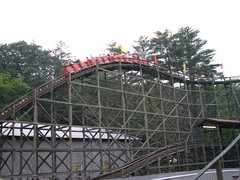 There is not one moment or maneuver that is superfluous to the Phoenix. No dog-legs found halfway along an otherwise straight run, no hills with profiling that needlessly distinguish themselves from the others (a possible exception being the double-up/double-down, but the air is very consistent). What distinguishes the Phoenix from other coasters is that there are no features that try to stand out from the others. Most people who have been on the ride and loved it show appreciation for the coaster as a whole, instead of singling out certain ‘big moments’ that the modern tendency of coaster design has us doing. The turns and hills are all very uniform, with the only difference between them being that as the ride looses speed to friction and the hills are reduced in scale the timing between them becomes tighter for that steadily increasing pacing effect.
There is not one moment or maneuver that is superfluous to the Phoenix. No dog-legs found halfway along an otherwise straight run, no hills with profiling that needlessly distinguish themselves from the others (a possible exception being the double-up/double-down, but the air is very consistent). What distinguishes the Phoenix from other coasters is that there are no features that try to stand out from the others. Most people who have been on the ride and loved it show appreciation for the coaster as a whole, instead of singling out certain ‘big moments’ that the modern tendency of coaster design has us doing. The turns and hills are all very uniform, with the only difference between them being that as the ride looses speed to friction and the hills are reduced in scale the timing between them becomes tighter for that steadily increasing pacing effect.
 The Phoenix is championed as having “a lot of airtime” which I think is a misleading turn of phrase since it implies the essence of the ride is found in it having traditional forces which is not at all what is happening here (bring on board an accelerometer and I doubt the Phoenix will outperform many laid-back family coasters in terms of raw numbers). Those regular kinds of forces are always described in a way that evokes something external to the body acting upon it, against your free will (à la El Toro’s ‘extreme ejector air’). Here, the airtime seems to start within the body, it is yourself that becomes free from the normal physical barriers of a materialist world, and with that freedom you choose to levitate upwards. It can only be likened to that moment immediately after death when your body looses all physical dimensions and you begin your ascent into heaven as a free spirit, it is that ethereal of an experience.
The Phoenix is championed as having “a lot of airtime” which I think is a misleading turn of phrase since it implies the essence of the ride is found in it having traditional forces which is not at all what is happening here (bring on board an accelerometer and I doubt the Phoenix will outperform many laid-back family coasters in terms of raw numbers). Those regular kinds of forces are always described in a way that evokes something external to the body acting upon it, against your free will (à la El Toro’s ‘extreme ejector air’). Here, the airtime seems to start within the body, it is yourself that becomes free from the normal physical barriers of a materialist world, and with that freedom you choose to levitate upwards. It can only be likened to that moment immediately after death when your body looses all physical dimensions and you begin your ascent into heaven as a free spirit, it is that ethereal of an experience.
Well, needless to say I treated myself to a few more rides on the Phoenix, in the back row and the Herb Schmeck seat, both also quite exquisite but truth be told the front was still the place to be. Actually I found the greatest advantage of riding in the back that was largely absent from a front seat ride was the ability to watch the people in the rows ahead of me and share in their collective joy in riding the Phoenix. I remember one ride (I think I was in row 1-3) in which the two would-be tough, disinterested teenage boys in the row ahead of me were giggling like schoolgirls by the time we reached the final series of bunny hills, which for me was the most satisfying part of that particular ride experience. With every ride there is a new opportunity for a unique, shared social experience that will set it apart from the last; twenty-four unrelated strangers all somehow connected in their uniform delight as the coaster goes through its motions. Modern rides are placing more emphasis on the individual’s riding experience with separate seating arrangement, engulfing personal restraints and staggered rows or ‘stadium seating’…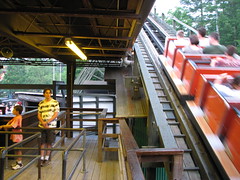 all of which could be justified in the name of increased safety, intensity and better, unobstructed views of the action, yet it’s also ultimately somewhat alienating, and forgetting of the original social intent of why amusement parks were devised in the first place. I can’t help but be reminded of the reverse effect cell phones have had on contemporary culture as well, instead of increasing interpersonal communications and strengthening social bonds they have instead reduced them, serving as a means to alienate people from their social surroundings. A slightly flawed analogy, I know, but I think it helps illustrate the point I’m trying to get at and how Knoebels represents a refreshing break from this trend of growing alienation both in the amusement park bubble and outside in the whole of society.
all of which could be justified in the name of increased safety, intensity and better, unobstructed views of the action, yet it’s also ultimately somewhat alienating, and forgetting of the original social intent of why amusement parks were devised in the first place. I can’t help but be reminded of the reverse effect cell phones have had on contemporary culture as well, instead of increasing interpersonal communications and strengthening social bonds they have instead reduced them, serving as a means to alienate people from their social surroundings. A slightly flawed analogy, I know, but I think it helps illustrate the point I’m trying to get at and how Knoebels represents a refreshing break from this trend of growing alienation both in the amusement park bubble and outside in the whole of society.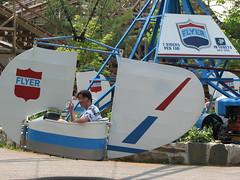
A few laps of Phoenix under my belt within less than a half-hour it was clear that crowds weren’t going to be anywhere near an issue as I had originally feared, so it was time to check out the rest of Knoebels. I first found myself waiting in line for their Flyers flying scooters ride, a ride model from my understanding that has quite a large cult following, and this installation in particular is apparently the equivalent of Spinal Tap. So I was quite a bit curious to see what the fuss was about. No doubt it ran much faster and better than any other flying scooter I had ever been on, but the connoisseurs speak much about a phenomenon known as ‘snapping’, which I have never been able to completely understand, much less achieve. It sounds as if one is able to get enough lift that they have a moment of slack in their cable on the descent thus creating a snap. Now I was able to observe a cycle or two of this ride while in line as well as my own cycle that consisted of some pretty aggressive maneuvering of my paddle, and I must say if my understanding of what constitutes snapping is correct, then I would like to declare it a fable. While an extra speedy rotation might allow for more height to be achieved, that comes at the expense of increased centrifugal forces, which will ensure that unless you are somehow able to completely invert your scooter, the cable will remain taut at all times. To actually achieve a ‘snap’ would require that some inward force is somehow exerted to counteract the outward forces of the rotation, and while there were some perilously low-hanging tree twigs nearby that I suppose an expert could possibly bump against if they mustered a lot of swinging momentum, I really don’t see how ‘snapping’ is even physically possible, let alone something that could be achieved by itself if the ride is fast enough. Perhaps someone can correct me and explain exactly how it is done.
of slack in their cable on the descent thus creating a snap. Now I was able to observe a cycle or two of this ride while in line as well as my own cycle that consisted of some pretty aggressive maneuvering of my paddle, and I must say if my understanding of what constitutes snapping is correct, then I would like to declare it a fable. While an extra speedy rotation might allow for more height to be achieved, that comes at the expense of increased centrifugal forces, which will ensure that unless you are somehow able to completely invert your scooter, the cable will remain taut at all times. To actually achieve a ‘snap’ would require that some inward force is somehow exerted to counteract the outward forces of the rotation, and while there were some perilously low-hanging tree twigs nearby that I suppose an expert could possibly bump against if they mustered a lot of swinging momentum, I really don’t see how ‘snapping’ is even physically possible, let alone something that could be achieved by itself if the ride is fast enough. Perhaps someone can correct me and explain exactly how it is done.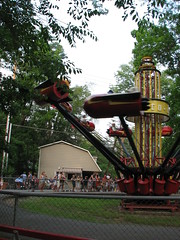
One other flat in the area I later tried was their indoor Cosmotron, which I was anticipating a great deal after flying through DelGrosso’s Space Odyssey six days earlier. I must say I actually foundDelGrosso’s version to be the better ride, with a more varied special effects package and more intense program. I guess that’s really all they have over there, so Knoebels shouldn’t be too worried about the competition. I also would have loved to have taken the Roto-Jets for a twirl, they just looked so amazingly retro and picturesque surrounded by so many tall trees, but between the fact that the median age of those in line appeared to be born well after Clinton left office, and with no other flats aficionados to justify my standing in such a line, I somehow never ended up climbing aboard.
I think the order of events after that were a few laps on Twister before getting some food. Lines were quite expedient for Twister as well, despite my first wait starting well down the steps out of the station. What I think did it was that there are no seat-belts or airgates to be found anywhere near the ride (and this was even more true of the Phoenix, with its single position buzzbars instead of individual ratcheting lapbars), everyone was able to quickly get in and sit down as soon as a train came to a halt, and could have lapbars down and ready to go within seconds, not having to worry about messing around with their seatbelts. Not only does the lack of seatbelts allow for added rider freedom without sacrificing any safety that isn’t already redundant, but they allow for one less thing for the ops to check. One of the girls checking restraints unfortunately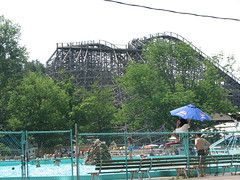 only had one arm to work with, but she was able to get her entire side of the train checked in under thirty seconds, blowing away every other park for dispatch times I’ve ever been to. They would consistently have one train ready for dispatch while the other was just circling the helix that surrounds the station, and then have that train ready to dispatch while the other one was circling the station. Quite an impressive feat. The only ride crews I would possibly rank above Knoebels are Dollywood’s Thunderhead crew (for friendliness, courtesy and efficiency) and Cedar Point’s Magnum crew (sheer capacity, being statistically the most popular ride in the park yet frequently with waits under 15 minutes while other lines in the park last more than two hours).
only had one arm to work with, but she was able to get her entire side of the train checked in under thirty seconds, blowing away every other park for dispatch times I’ve ever been to. They would consistently have one train ready for dispatch while the other was just circling the helix that surrounds the station, and then have that train ready to dispatch while the other one was circling the station. Quite an impressive feat. The only ride crews I would possibly rank above Knoebels are Dollywood’s Thunderhead crew (for friendliness, courtesy and efficiency) and Cedar Point’s Magnum crew (sheer capacity, being statistically the most popular ride in the park yet frequently with waits under 15 minutes while other lines in the park last more than two hours).
 In keeping with this spirit of efficiency myself, on one visit to the back seat I noticed that only on girl probably around 14 years old was waiting ahead of me, her two friends waiting for the row ahead. Well 1+1=2, and I always hate it when I’m forced to wait an extra ride because there are two single riders ahead of me who each want to ride separately instead of riding together, so I ask her if it’s alright if I ride with her. “Uhh… sure” was my reply. Followed by much nervous giggling.
In keeping with this spirit of efficiency myself, on one visit to the back seat I noticed that only on girl probably around 14 years old was waiting ahead of me, her two friends waiting for the row ahead. Well 1+1=2, and I always hate it when I’m forced to wait an extra ride because there are two single riders ahead of me who each want to ride separately instead of riding together, so I ask her if it’s alright if I ride with her. “Uhh… sure” was my reply. Followed by much nervous giggling.
Note to self: While I might like to think of myself as some sort of rational, Hegelian species-being, neutralized and divorced of all social roles and labels, the fact is that that is not what a 14 year-old girl thinks when a 20 year old college student who hasn’t shaved in several days asks her if they can sit in extremely close proximity to each other for the next couple minutes. I mentioned in my review of the Phoenix how the more social setting can create new experiences with each ride. The same is true of the Twister, and this particular ride could be labeled as a distinctively ‘awkward’ experience compared to all the rest.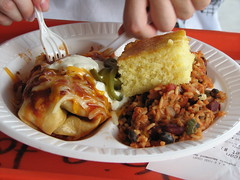
This report would not be complete without mentioning the food, for which I believe they have won the Golden Ticket Award every single year since the award’s inception. Looking over the map it seemed the International Food Court would be the place to dine, which was true, as they had a huge menu. I can’t say my food was best of any amusement park in the world, but it was decent, and I’d probably need more than one meal at the park before making any definitive declarations. It does make me wonder why the quality of in-park meals at amusement and theme parks across the country is so noticeably lower than what you’d find outside the park. If it’s not concession-style dining, then it’s low quality, and if not low quality, then it’s overpriced (and normally some combination of the three). There must be some fundamental difference between having a restaurant operated as an entity within a larger business versus as its own independent business, perhaps in the way they deal with food distributors, or the way management is structured, or maybe it’s just the lack of a free-market competitive environment that’s found inside amusement parks. When I think of great, affordable (and clearly profitable) restaurants I’ve been to in cities like my hometown, I can’t help but think, “why would it be so hard to run an establishment exactly like this but within an amusement park?” Maybe it’s just because amusement park patrons would always leave such lousy tips.
 There’s another consistent award winner at the park that I was curious to see if it lived up to the hype as well: The Haunted Mansion. This ride is not included all-day, all inclusive wristband (along with the pool and their chairlift), supposedly because Dick Knoebel wanted to retain the open, up close feel to the ride rather than block off sets like is found on most other dark rides, but had to find a way to prevent kids from getting bored with it after multiple re-rides and possibly jump off the attraction and vandalize the props. It’s easy to see why that could be a problem, as this ride is very tightly packed together, it’d be quite easy at points to reach out and touch whatever is jumping towards you. That said, I unfortunately don’t remember too much in specific from the ride, other than that it had a very claustrophobic, traditionalist feel to it. The nostalgic value is apparent for Golden Ticket and DAFE voters, and I can’t say I’ve ever been on another old-school dark ride that rivals the Haunted Mansion. Still, I can’t help but feel that if modern-day creative designers could work with the same freeform parameters and props the Haunted Mansion has, a better ride is at least imaginable, since the Haunted Mansion is mostly just a mishmash collection of retro gags. If it were still around I’d have to vote for Nights in White Satin as my favorite dark ride, just because it’s on a whole different level from every other gag-based dark ride in existence, even though I still felt in many ways it was a flawed attraction. I will therefore declare Haunted Mansion as my new favorite dark ride (best competition it had in my book was Indiana Beach’s Den of Lost Pirates),
There’s another consistent award winner at the park that I was curious to see if it lived up to the hype as well: The Haunted Mansion. This ride is not included all-day, all inclusive wristband (along with the pool and their chairlift), supposedly because Dick Knoebel wanted to retain the open, up close feel to the ride rather than block off sets like is found on most other dark rides, but had to find a way to prevent kids from getting bored with it after multiple re-rides and possibly jump off the attraction and vandalize the props. It’s easy to see why that could be a problem, as this ride is very tightly packed together, it’d be quite easy at points to reach out and touch whatever is jumping towards you. That said, I unfortunately don’t remember too much in specific from the ride, other than that it had a very claustrophobic, traditionalist feel to it. The nostalgic value is apparent for Golden Ticket and DAFE voters, and I can’t say I’ve ever been on another old-school dark ride that rivals the Haunted Mansion. Still, I can’t help but feel that if modern-day creative designers could work with the same freeform parameters and props the Haunted Mansion has, a better ride is at least imaginable, since the Haunted Mansion is mostly just a mishmash collection of retro gags. If it were still around I’d have to vote for Nights in White Satin as my favorite dark ride, just because it’s on a whole different level from every other gag-based dark ride in existence, even though I still felt in many ways it was a flawed attraction. I will therefore declare Haunted Mansion as my new favorite dark ride (best competition it had in my book was Indiana Beach’s Den of Lost Pirates),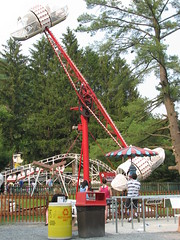 although I still say my personal scariest dark ride experience was the Haunted Hotel or whatever it was at the defunct Myrtle Beach Pavilion. Haven’t been on it since I was seven. All I remember was nervously trying to convince myself there wasn’t anything to be afraid of as we go through the first scenes. Then with a loud crack of lightning, two skeletons I was not anticipating very quickly jump out of a bed and scream. Hands up and over the eyes! What a pansy, but hey, I was seven, and those slumbering skeletons still remain etched in my memory to this day, lame as I’m sure I’d find it now.
although I still say my personal scariest dark ride experience was the Haunted Hotel or whatever it was at the defunct Myrtle Beach Pavilion. Haven’t been on it since I was seven. All I remember was nervously trying to convince myself there wasn’t anything to be afraid of as we go through the first scenes. Then with a loud crack of lightning, two skeletons I was not anticipating very quickly jump out of a bed and scream. Hands up and over the eyes! What a pansy, but hey, I was seven, and those slumbering skeletons still remain etched in my memory to this day, lame as I’m sure I’d find it now.
Hidden farther back in what is obviously the older section of the park were several more rides worth trying, first up being the Satellite (aka Roll-O-Plane, aka Salt and Pepper Shakers). I wish flat ride manufactures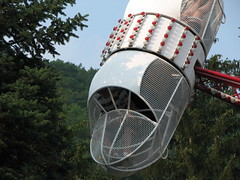 would continue making rides this evil. Two arms that rotate in a vertical 360 degree loop, with a carriage attached to either end that rotates horizontally on its axis rather than vertically like a Ferris wheel. No problem, right? Well, there’s the slight problem of what the cars want to do when they go past vertical, and they’ve got to start flipping on their port and starboard sides to remain on an even keel, all while you’re pulling some heavy g-forces as the arms swing you around the bottom. That’s what’s called a fun time. I’d love to get to Georgia’s Lake Winnie sometime to try their Fly-O-Plane, the only remaining version of that O-Plane model left in existence.
would continue making rides this evil. Two arms that rotate in a vertical 360 degree loop, with a carriage attached to either end that rotates horizontally on its axis rather than vertically like a Ferris wheel. No problem, right? Well, there’s the slight problem of what the cars want to do when they go past vertical, and they’ve got to start flipping on their port and starboard sides to remain on an even keel, all while you’re pulling some heavy g-forces as the arms swing you around the bottom. That’s what’s called a fun time. I’d love to get to Georgia’s Lake Winnie sometime to try their Fly-O-Plane, the only remaining version of that O-Plane model left in existence.
Also in the area was the High Speed Thrill Coaster, which has gained notoriety as being the best children’s coaster for adults, thanks to a six-cylinder Chevrolet engine hooked up to the chain lift that can be adjusted in speed per the ride op’s discretion. I wasn’t expecting it to be running full tilt on a normal operating day, but watching a train cycle before me it was clear that this (loud!) kiddy ride could provide quite a bit of sharp ejector air even in normal mode from the back row. Seating choices were first-come first serve, and while I found myself behind a nervous little kid with his mother, they opted for a middle seat while I then took the back. The first lap was more of a warm up (the motor needs the train to hit it with some speed from a prior before it yank it up at top speed), but even then a bit of air was present from my perch on the first go round. While I’m ready for more, that nervous kid I mentioned earlier clearly had enough and before we got our  second lap the mom was indicating to the operator that they need to tone it down. So he does, and I barely creep over the hill on the next lap. And the next, and then next, until it’s over. On the exit I was about to get in line to try it again for a *proper* High Speed Thrill Coaster experience, but a cavalcade of kiddies just beat me and I decided it wasn’t worth waiting at least two cycles for a re-ride of a kiddy coaster. I figure I can try it again next time I’m at Knoebels, it’s been here since 1955 after all, so it’s not like it’s going anywhere soon. Unfortunately as I already mentioned earlier in this review, the HSTC is on its way out for good this season, so I guess I’ll never know what the full potential of this unique attraction was really like. Since I never got to say anything while at the park, I’ll say it here:
second lap the mom was indicating to the operator that they need to tone it down. So he does, and I barely creep over the hill on the next lap. And the next, and then next, until it’s over. On the exit I was about to get in line to try it again for a *proper* High Speed Thrill Coaster experience, but a cavalcade of kiddies just beat me and I decided it wasn’t worth waiting at least two cycles for a re-ride of a kiddy coaster. I figure I can try it again next time I’m at Knoebels, it’s been here since 1955 after all, so it’s not like it’s going anywhere soon. Unfortunately as I already mentioned earlier in this review, the HSTC is on its way out for good this season, so I guess I’ll never know what the full potential of this unique attraction was really like. Since I never got to say anything while at the park, I’ll say it here:
Thanks a lot, kid, for freaking out on my one and only ride of this classic. I may have been a wuss on dark rides at your age, but at least I knew how to compose myself on a kiddy coaster. I suppose I’ll have some small solace in knowing that someone like that probably won’t get laid until they turn 30.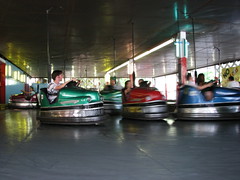 Come to think of it, it’s probably best I never said anything.
Come to think of it, it’s probably best I never said anything.
Another ride I’ve heard much about and needed to try first hand was their Scooter bumper cars. These are quite excellent for bumper cars, although for a proper bumper car experience it’s always better with friends. Knoebel’s version has an ovular corral layout to it, which tends to result in a lot more side-slams, where two people are cruising side by side and one, or both, quickly veers into the other. While not quite as satisfying as a head-on or deflected head-on collision (usually only possible with an open-floor layout), that’s probably the best in this case, since the heavy steel Lusse cars are able to really slam each other around and a head-on collision would probably result in whiplash.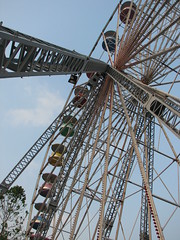
My dad bought tickets to join me on the final three non-coaster rides of the night as well, which ended up being the Giant Wheel (mostly to get photos, although it’s amazing how much of the nearby park remains hidden from view thanks to the trees), Flume (a bit wet and a nice setting), and later that night, the Looper. That last one ended up being an exercise in futility, since the looping ability of the cars depends on the riders input. To describe the ride to those not familiar, it’s basically a set of ten or so two-person cars that look like wheels set around a giant turning axis. There’s no up or down motion like on a Himalaya or anything, it’s just slowly rotates along a flat circle, with the individual cars spinning upside down. The way I think it’s set up is there’s a pedal and pivoting handlebar, and adjusting these just right will cause our wheel to lock in against the spinning mechanism and we’ll start flipping. The only problem was, no one on the ride staff ever really explained how to do this besides “use the pedal”, so we kept on rocking as far back and forth as we could push our car while trying to grind the pedal or the handlebar down in various ways, none of which ever had any effect. Fed up with that, I decided I needed one last flat before the night was over, preferably one that I could simply sit there and ride rather than be forced to be an active participant, and the Fandango (a KMG Afterburner, I think?) answered that call. Set next to the Phoenix’s far turn in a relatively new corner of Knoebels, it feels almost like you’ve left the park by the time you get to it, as it’s situated on a large gravel field next to an access road to the campgrounds. This is partly what I love about open-gate parks like Knoebels, is that this small road is actually the fastest pathway to get between the Phoenix and Twister, although there were no lights along it like a traditional midway so it was a bit of a stumble in the dark as we hurried to get final rides on each of these coasters.
Fed up with that, I decided I needed one last flat before the night was over, preferably one that I could simply sit there and ride rather than be forced to be an active participant, and the Fandango (a KMG Afterburner, I think?) answered that call. Set next to the Phoenix’s far turn in a relatively new corner of Knoebels, it feels almost like you’ve left the park by the time you get to it, as it’s situated on a large gravel field next to an access road to the campgrounds. This is partly what I love about open-gate parks like Knoebels, is that this small road is actually the fastest pathway to get between the Phoenix and Twister, although there were no lights along it like a traditional midway so it was a bit of a stumble in the dark as we hurried to get final rides on each of these coasters.
Twister is interesting. Despite all the shout-outs this park gets in enthusiast circles, between the food, classic flats, the Haunted Mansion and especially the Phoenix, I was always surprised and suspicious by the general silence surrounding the Twister. It has a pedigree that seems like it should be a much more celebrated attraction, being a redesign of Denver’s much-loved Mr. Twister, featuring skid brakes and efficient operations, and perhaps most importantly it stands as the perfect counterpoint to the airtime laden Phoenix. Is it just that straight airtime hills are that much more popular than twists and turns, or was there something else I was missing. The Twister wasn’t (gasp) rough, was it? After trying out both first-hand, I can honestly say I’m still at a loss for why Twister usually plays such a second-fiddle role to the Phoenix.
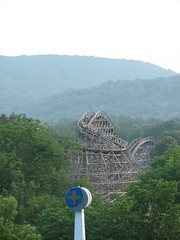 Twister starts off with a threesome of nearly identical turnarounds, making the bread of a lift hill club sandwich. While the split lift hill by itself would be unique enough, I found that by having three identically shaped turns (characterized by a short left turn downward before sweeping right, where it eventually climbs upward and slows to a near stop once again) really added a lot of to the overall ride. Each progressive turn piles on a few more laterals at the base, while each is also situated a good 50 ft. higher than the previous. There’s also a clever psychological trick, in having the first two turns
Twister starts off with a threesome of nearly identical turnarounds, making the bread of a lift hill club sandwich. While the split lift hill by itself would be unique enough, I found that by having three identically shaped turns (characterized by a short left turn downward before sweeping right, where it eventually climbs upward and slows to a near stop once again) really added a lot of to the overall ride. Each progressive turn piles on a few more laterals at the base, while each is also situated a good 50 ft. higher than the previous. There’s also a clever psychological trick, in having the first two turns  (the one out of the station and the one splitting the lifts) both end with just another lull. The same effect is achieved on the final turnaround, but instead of a complete lull of another lift lift, there’s only a moment’s pause perched on the pinnacle of that hill, before it dives down the steep dive into the dark tangles of knotted wood below.
(the one out of the station and the one splitting the lifts) both end with just another lull. The same effect is achieved on the final turnaround, but instead of a complete lull of another lift lift, there’s only a moment’s pause perched on the pinnacle of that hill, before it dives down the steep dive into the dark tangles of knotted wood below.
Front or back, that first drop is fantastic, feeling like it ought to belong to a ride much bigger than what we’ve been made to anticipate. The train surges up into an elevated turnaround that’s slightly reminiscent of the starter three we just had, only this one is passed over much more quickly since these curves now work as the pause between the real action which is these very steep drops. The second drop is nearly just as great as the first, supplying airtime to all seats while once again diving down down down into the shadows of the lumber cobwebs.
into the shadows of the lumber cobwebs.
From here it quickly transitions into a fast and forceful double inclined helix. So this is why they call it the Twister. Plenty of mean, lean and sustained laterals with speeds that ebb and flow as train climbs and descends the tilted helix. It’s not just a beautiful centerpiece from off ride (especially from the exit ramp which it fully encloses) but from on-ride as well, signaling the extended midpoint between the steep suicidal plunges found in the first half to the faster paced, more tightly plotted second half.
Alright, so maybe the second half doesn’t work quite as well as everything that came before it. Truth be told I’d have to check a video to figure out exactly what the ordering of the proceedings were in the second half, but I guess that’s kind of what you want out of a twister, a layout that can never be fully comprehended or expected even after multiple re-rides. It makes some fast, high banked turns deep within the super structure mixed with some drawn-out, oddly banked bunny hops. The fact that there’s very little airtime over these I suspect may be part of the reason Twister is overlooked by enthusiasts preferring the Phoenix’s abundant air over every hill, but that’s why these two rides are perfect counterpoints to each other. A cool underground tunnel finishes off one of the final turns, emerging to a final dip before sliding into the curved skid brake runway that leads back to the station.
but I guess that’s kind of what you want out of a twister, a layout that can never be fully comprehended or expected even after multiple re-rides. It makes some fast, high banked turns deep within the super structure mixed with some drawn-out, oddly banked bunny hops. The fact that there’s very little airtime over these I suspect may be part of the reason Twister is overlooked by enthusiasts preferring the Phoenix’s abundant air over every hill, but that’s why these two rides are perfect counterpoints to each other. A cool underground tunnel finishes off one of the final turns, emerging to a final dip before sliding into the curved skid brake runway that leads back to the station.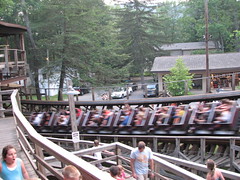
While it might not be on quite the level of intensity of some of GCI’s more recent creations (although don’t underestimate that centerpiece double helix) and it’s certainly lacking much of the pure joy to be found in the Phoenix, for me Twister would rank very highly as a coaster designer’s coaster, a ride that features a full canon of different moves and maneuvers, never getting pegged down as a coaster that only does one thing, yet never being remembered as a coaster that’s just a random mishmash of different things. It’s tightly plotted, a bit elusive, a bit more vexing when first trying to figure out exactly what it’s ‘about’, but with enough re-rides (especially at night, when the superstructure underpasses and final tunnel are pitch black…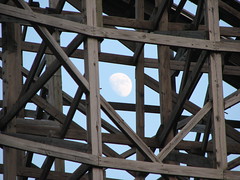 thank you Knoebels for keeping the lights off around this ride) I really came around to appreciating this ride more as an equal to the Phoenix rather than simply ‘that other wooden coaster”.
thank you Knoebels for keeping the lights off around this ride) I really came around to appreciating this ride more as an equal to the Phoenix rather than simply ‘that other wooden coaster”.
Speaking of the high and mighty Phoenix, I should mention that throughout the day the Phoenix suffered a fall from grace in my books. Throughout the afternoon and especially on the last evening rides (including the last ride of the night in the front row) the airtime seemed to grow weaker and weaker along the course, eventually only really present on the final row of bunny hops. I couldn’t figure out if the ride was slowing down as the day wore on, or if the giddy effects of the airtime were starting to wear off on me after several re-rides and I was simply beginning to look for more out of this coaster than just a series of straight hills and flat turns. Whatever it was, by those final rides it was clear that Phoenix was no more in the top five for me. At the end of the trip my appraisal of the Phoenix sunk to number 15 on my wooden coaster list. Perhaps a bit harsh given how much I loved my first few rides on it (I still rate Shivering Timbers based on how I remember it running back around 1999 rather than present-day conditions) but I think if it weren’t for those first rides there would be little holding me back from dismissing it altogether based on how poorly it performed later in the day. I still remain optimistic that I can catch it on a better day sometime soon in the future and my original praise of the ride can be restored, but I suppose that would depend on if the ride really did slow down throughout the day (seems improbable, normally wooden coasters speed up as the grease warms) or if the more troubling conclusion that I grew board of the floater airtime was what really happened.
appraisal of the Phoenix sunk to number 15 on my wooden coaster list. Perhaps a bit harsh given how much I loved my first few rides on it (I still rate Shivering Timbers based on how I remember it running back around 1999 rather than present-day conditions) but I think if it weren’t for those first rides there would be little holding me back from dismissing it altogether based on how poorly it performed later in the day. I still remain optimistic that I can catch it on a better day sometime soon in the future and my original praise of the ride can be restored, but I suppose that would depend on if the ride really did slow down throughout the day (seems improbable, normally wooden coasters speed up as the grease warms) or if the more troubling conclusion that I grew board of the floater airtime was what really happened.
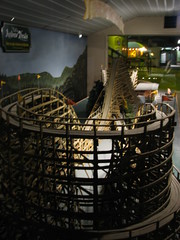 Knoebels or Kennywood? It’s almost unfair that these two giants of small parks have to be located in the same state since the comparisons between them become inevitable. Why can’t I just say they’re the two best preserved small parks left in the country, the only other places that can even begin to compare to either that I can think of are Indiana Beach and Denver’s Lakeside Park (probably some others I haven’t been to as well, the Santa Cruz Beach Boardwalk jumps to mind). They’re really quite different breeds of park. Kennywood is a perfect preservation from its 1920’s to 1940’s glory days, presented with an almost Disney-esque flair for modern audiences. Knoebels is, simply put, directly transplanted from the 1960’s, a slightly seedy rural resort park then, just as it is now, just as it will most likely always will be. But I suppose if I must choose… Kennywood. I won’t feel too guilty since online polls and the Golden Ticket Awards have shown a clear tilt towards Knoebels and I love being in the minority of Kennywood supporters. I suppose my initial reservations towards Knoebels didn’t help much but I still must tip my hat to the Pittsburgh icon. Kennywood is much more logical and better presented in its shoehorning of quirky classic attractions around one another.
Knoebels or Kennywood? It’s almost unfair that these two giants of small parks have to be located in the same state since the comparisons between them become inevitable. Why can’t I just say they’re the two best preserved small parks left in the country, the only other places that can even begin to compare to either that I can think of are Indiana Beach and Denver’s Lakeside Park (probably some others I haven’t been to as well, the Santa Cruz Beach Boardwalk jumps to mind). They’re really quite different breeds of park. Kennywood is a perfect preservation from its 1920’s to 1940’s glory days, presented with an almost Disney-esque flair for modern audiences. Knoebels is, simply put, directly transplanted from the 1960’s, a slightly seedy rural resort park then, just as it is now, just as it will most likely always will be. But I suppose if I must choose… Kennywood. I won’t feel too guilty since online polls and the Golden Ticket Awards have shown a clear tilt towards Knoebels and I love being in the minority of Kennywood supporters. I suppose my initial reservations towards Knoebels didn’t help much but I still must tip my hat to the Pittsburgh icon. Kennywood is much more logical and better presented in its shoehorning of quirky classic attractions around one another. 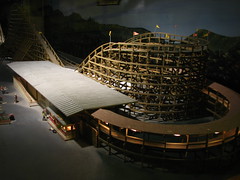 Knoebels, while perhaps slightly more authentic with their homespun retro charm, is basically a respectable fairground in the middle of a forested mountain valley. I had a sense standing in Knoebels that one corner of the park was very much like any other, while Kennywood has many unique sections. Plus, I have to give the edge to Kennywood for a better selection of rides. Flats are pretty neck and neck, but between the trio of authentically
Knoebels, while perhaps slightly more authentic with their homespun retro charm, is basically a respectable fairground in the middle of a forested mountain valley. I had a sense standing in Knoebels that one corner of the park was very much like any other, while Kennywood has many unique sections. Plus, I have to give the edge to Kennywood for a better selection of rides. Flats are pretty neck and neck, but between the trio of authentically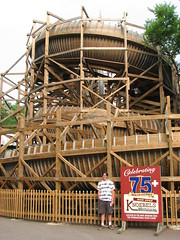 classic wooden coasters to match Knoebel’s three (one relocation and two re- creations, one still under construction), and Kennywood’s three dark rides to Knoebel’s one admittedly superior attraction; plus the Exterminator (though soon to be matched by the Golden Nugget) and the phenomenal steel cornerstone that is Phantom’s Revenge… if a friend asked which to do when they only had the time and budget to do one, I would find myself recommending Kennywood before Knoebels.
classic wooden coasters to match Knoebel’s three (one relocation and two re- creations, one still under construction), and Kennywood’s three dark rides to Knoebel’s one admittedly superior attraction; plus the Exterminator (though soon to be matched by the Golden Nugget) and the phenomenal steel cornerstone that is Phantom’s Revenge… if a friend asked which to do when they only had the time and budget to do one, I would find myself recommending Kennywood before Knoebels.
Overall a great park, and it’s definitely at the top of my list of parks to revisit in the near future, especially with both Flying Turns and the Golden Nugget (I believe to be renamed ‘Black Diamond’) on the horizon. Just one park left to the trip, featuring possibly my most anticipated single attraction: Waldameer.
–

Nice review! Just a couple quick comments, as a huge fan of this park.
One, I wish I could give you a good physics-based explanation for how snapping works, but unfortunately that isn’t really my strong point. I don’t have any idea how or why it does, but I definitely can say that it can be done. I’ve done it myself (though entirely by accident), and have video evidence, as my girlfriend was recording the ride and I managed enough of a snap that you can clearly see the slack in the cable. If she still has the video around, I’ll have to see it I can put it up on youtube.
Second, as far as the food, the International Food Court is decent but in my opinion probably the worst food in the park. If you really want to be impressed, make sure you eat at the Alamo restaurant next time you visit the park; I’m pretty sure it’s the biggest reason for the golden ticket awards. The food is simple but absolutely perfect every time, prices are very reasonable, and the service is fantastic.
Rai, thanks for your reply. Yeah, obviously snapping is too widely-covered a phenomenon for it to be a fable, and part of my point with that paragraph was to make a tongue-in-check defense to try to cover up the fact that I wasn’t able to achieve something that people say can happen by itself by that ride. Also thanks for the advice on food, I didn’t do much research on where the best places to eat were before visiting so when we looked at the map, the big International Food Court that offered a bit of everything seemed like a safe place to go. I’ll definitely remember to try out the Alamo the next time I’m in town. Are there any other great eating locations in the park I should pay particular attention to?
Snapping is definitely possible.
I think the problem most new people have is that they actually try TOO hard. If you move the wing a bunch you don’t anywhere.
The trick is to gain your momentum up and down (an arc). Start by slowly moving the wing left and right as you should feel your tub going up and down higher and higher. When you feel your arc is high enough (almost vertical), at the very top break the arc by very quickly turning the wing to the far left. Once at the bottom turn the wing quickly to the opposite direction. You are in for quite a ride at this point.
If you ever visit again, visit during the PPP weekend… that event alone is usually why the Phoenix and Knoebels rank so high on the polls.
Hope this helps.
I’ve been riding Knoebel’s Flyer for the past 24 years, and have been operating it for 2 years. It gave me insight as to what causes it to snap it’s cables. Brian is right on how to do it, but what causes it?
Take a look at the Flying Scooter tub. It’s a tub with two sails, a moveable front sail, and a fixed rear sail. It is suspended by 4 cables (2 front, 2 rear) between two sweeps. The tub is centered between those two sweeps. The sweeps move at a consistent rate, and you make your flying scooter tub go up and down by turning the front of the sail so that the wind resistance would pivot the tub, and then you would use both front and rear sails to gain enough wind resistance to move the tub either outward or inward, depending on which side of the sails the wind resistance hits. Wind is basically air moving, but in this case you are moving against the air, hence “wind”. If there was a cross-wind the dynamics changes. That’s why it’s more thrilling on the Flyers when there’s a cross wind because it constantly changes the dynamics and a gust can wreak havoc on your flight path.
Now you have a tub centered between two sweeps with the sweeps going at a constant rate. Notice that Brian states that the downward motion is what starts the cable snapping. Why downward? Why not upward? The reason is this: gravity. Gravity is always constantly trying to pull any body back to earth. Centrifugal force overcomes gravity and makes the tub move outward when the ride moves. Wind resistance also adds to the centrifugal force to make the tub move out. Wind resistance and gravity overcomes centrifugal force to move inward. By moving downward, you use wind resistance and gravity to gain speed. You basically “dive-bomb” your flying scooter. As you go down, you’re moving sideways as the same rate as the sweeps. You are still centered between the sweeps. When you level out, the front cable goes slack. Why? You are actually turning the tub into the same direction as the sweeps. With all that momentum you gained from that downward force you are actually moving at a faster rate than the sweeps. The cables only have a pulling force on the tub. By moving faster than the sweeps, you move off-center in relation to the sweeps. Since the cables can’t push on an object, the front cable goes slack because you are now off-center towards the front sweep. Now that the back cable is pulling on the tub, and not the front cable (even though everything is moving forward, there is no forward pulling force on the front of the tub), you loose momentum quickly as the sweeps catch up with the tub and try to return the tub to it’s centered position. The tub finally returns to it’s centered position, and the forward cable snaps taut and starts pulling the tub forward, but due to the mass of the tub and it’s rider, the equalization of the tub’s forward momentum and the sweep’s momentum is a bit slow. The sudden increase in the force of the front cable trying to pull the tub forward is what causes that “snap”. Since the mass of the tub and rider causes the forward momentum to respond slowly, the back cable goes slack as the tub tries to catch up with the sweeps. At the same time, centrifugal force combined with wind resistance makes the tub go upward. Since the tub is trying to catch up with the sweeps by moving forward a bit faster, you get that extra boost of height at the apex of the swing, all at the same time “snapping” the rear cables. If the forward momentum while trying to catch up to the centered position is great enough, you can end up overshooting the centered position as you dive back down. It is harder to overshoot the centered position while up in the air because you turn gradually into the direction of the sweeps while going up compared to the sharp turn at the bottom of the descent. The intensity of the snap all starts with the dive. The faster you dive, causing you to move more forward off center, then causing the tub to swing backwards to it’s centered state at a much faster rate, causing the cable to go taut more quickly and the forward force in pulling the tub to be much more higher.
You also can counteract the snapping by carefully controlling your ascent and descent rate so that you don’t move off center, or by gently bringing the tub back on center. You can also use this to control the snapping intensity as well. On your descent, you simply turn the tub upward to create a braking effect to lessen the off-center oscillation effect.
Parks can lessen the snapping by decreasing the speed so that you can’t go up as high to gain enough speed to overcome the forces and move the tub off-center. This is also why the smaller 8-tub models are harder to snap or has less snapping force compared to the larger 10 tub models like Knoebels- the 8 tub models don’t go as high as the 10 tub models therefore you can’t gain enough speed to get that big snap. They also put in stops on the tub’ front sail so that it makes it more difficult to turn the tub around more quickly and start the dive. With the stops, it is now all about timing- getting the tub to point downward at the highest apex possible of the flying scooter’s flight arc to gain the highest speed to move the tub more forward off-center.
Wow, thank you so much for your detailed reply! I probably should print both yours and Brian’s replies and bring them with me next time I visit a park with a Flying Scooters installed so that way I can see exactly what you meant play out in actuality. Now I just wish I didn’t have to wait so long to visit Knoebels again…
Cesasi’s pizza is also a must-try for food. They’ve won award after award for best amusement park pizza. While I’m not a huge fan of thin crust pizzas in general, they definitely have some of the best I’ve ever tried, and some of their more exotic varieties like their taco pizza are quite creative.
wow thats longgg
That’s what she said.
Just stumbled upon this page after not seeing it in a while and realized your picture of looking through the entrance of the park (with the Giant Wheel on the left) will look very different next year with the addition of the drop tower. The location will be perfect as right when you walk in it will be right in the center of your view peeking through the trees past the Power Surge. Seems they put alot of thought into the location so it has the most visibility from different places around the park. I am sure you will be also to see it from the phoenix area, near the Roto Jets, and from the pool area.
I was going to explain that snapping comes from slack in only one of the two cables, but I can’t beat RCoaster’s in depth explanation. Just move the sail back and forth slowly in pace with the swing, like pumping your feet on a playground swing. I’ve had those cars snapping so much I actually got scared I might fall out!